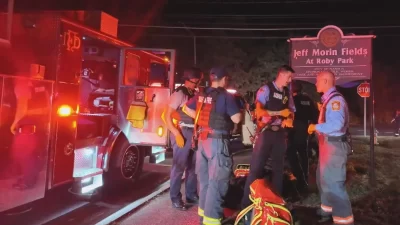Evaluating whether the horses belong in the park has “been a long time in coming, and it realigns us with our overarching policies to remove non-native species from parks whenever they pose a potential risk to resources,” said Jenny Powers, a wildlife veterinarian who leads the wildlife health program for the National Park Service.
One of the horses’ biggest advocates fears park officials have already decided to oust the horses. Chasing Horses Wild Horse Advocates President Chris Kman cites several alternatives for keeping horses that park officials considered but dismissed in the recent environmental assessment.
In the document, the Park Service said those alternatives wouldn’t be “in alignment with NPS priorities to maintain the native prairie ecosystem” and wouldn’t address the animals’ impacts, among its reasons.
Kman said she is “optimistic that we will ultimately win this fight. I don’t have any faith that the park will do the right thing and keep the horses in the park.”
Even if the horses ultimately stay, Park Superintendent Angie Richman said they would have to be reduced to 35-60 animals under a 1978 environmental assessment. The ongoing process is part of the park’s proposed management plan for “livestock,” a term the horses’ allies reject.
Wild horses were accidentally fenced into the park in its early years. They were eventually kept as a historic demonstration herd after years of efforts to eradicate them, according to Castle McLaughlin, who researched the horses’ history in the 1980s as a graduate student working for the Park Service in North Dakota.
Wild horse advocates would like the park to conduct a greater environmental review, and want to ultimately see a genetically viable herd of at least 150 horses maintained.
A vast majority of previous public comments opposed removal of the horses, making it “really difficult to understand why the government would choose to take them away from the American people,” said Grace Kuhn, communications director for the American Wild Horse Campaign.
The wild horses “have a right to be in the national park” and align with Roosevelt’s sentiment to preserve cultural resources for future generations, she said.
“Essentially, the Park Service by implementing a plan to either eradicate them quickly or eradicate them slowly, they’re thumbing their noses at the American public and their mission,” Kuhn said last month.
Burgum in January offered state collaboration for keeping the horses in the park. His office and park officials have discussed options for the horses. State management or assistance in managing the horses in the park are options North Dakota would consider; relocation is not, spokesperson for the governor’s office Mike Nowatzki said Monday.
Park officials “are certainly willing to work with the governor and the state to find a good outcome,” Park Superintendent Richman said last month, adding that the park was working with the governor on “a lot of different options.”
“It would be premature to share pre-decisional discussions at this time,” she said Wednesday.
Sen. Hoeven has worked on negotiations with park officials, and included legislation in the U.S. Interior Department’s appropriations bill to preserve the horses. “If that doesn’t get it done,” he would pursue further legislation, he said last month.
“My objective is to keep horses in the park,” Hoeven said.
The park’s ultimate decision also will affect nine longhorn cattle in the park’s North Unit. All of the horses are in the park’s South Unit.








